#ateji
Text
国名の当て字
カットの下に当て字の使い方と当て字をちゃんと認めるにはいいチップを詳しく説明します。でも最初、語彙リストをあげます。
america - 米国
canada - 加奈陀
finland - 芬蘭
germany - 独逸
england - 英国
france - 仏蘭西
india - 印度
ireland - 愛蘭
norway - 諾威
portugal - 葡萄牙
russia - 露西亜
spain - 西班牙
sweden - 瑞典
ukraine - 烏克蘭
当て字を使うときに国名を略することがよくあります。例:「米国」は「米」になります。同じように「仏蘭西」は「仏」になったり、「露西亜」は「露」になったり、「独逸」は「独」になったりします。しかし危ない!この略した漢字の読み方が変える可能性があります。例:アメリカとドイツの関連について書くときに、「米独」を使うと、読み方は「べいどく」に変化します。
そして特別な字は確立された読み方があります。例:「亜」はいつも「ア」と発音します。にしても、一字に2つ・3つの読み方があることもあります。「仏」を例にしては、「ふ/ぶ/ぷ」として発音できます。下のリストに普通の読み方が見せられます。
あ → 亜・愛・亞
か/が → 加
さ → 沙
す → 西
な → 奈
ひ/び/ぴ → 比
ふ/ぶ/ぷ → 仏
ら(ん) →欄・蘭・羅
り → 利・里・
ろ → 路
この上のリストは完璧ではありません。このリストは傾向を見せます。当て字はこのようにいつも発音させません。
#bc I really like this topic and wanted to remake this post from like 2 years ago#japanese langblr#japanese language#langblr#language#japanese#ateji#find later
70 notes
·
View notes
Photo
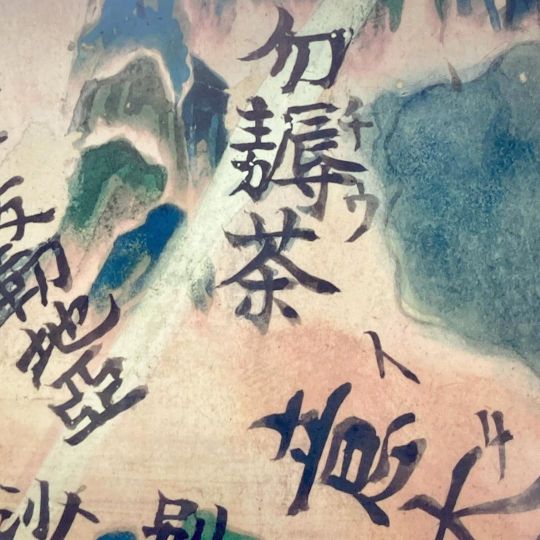
“Venezia” scritto in ateji su un paravento dipinto con la mappa del mondo di padre Matteo Ricci. • “Venice” written with ateji on a folding screen painted with the world map by father Matteo Ricci. • 屏風で描かれているマテオ・リッチ作「坤輿万国全図」に当て字で書いた「勿耨茶」(ヴェネツィア)。 ••• #matteoricci #mappa #mondo #geografia #paravento #venezia #linguagiapponese #kanji #ateji #map #antiquemap #worldmap #venice #geography #foldingscreen #japaneselanguage #池田家文庫 #マテオリッチ #坤輿万国全図 #地図 #世界地図 #地理学 #屏風 #ヴェネツィア #日本語 #漢字 #当て字 #tè #tea #茶 (presso 林原美術館 Hayashibara Museum of Art) https://www.instagram.com/p/CoZ8D-lBgfO/?igshid=NGJjMDIxMWI=
#matteoricci#mappa#mondo#geografia#paravento#venezia#linguagiapponese#kanji#ateji#map#antiquemap#worldmap#venice#geography#foldingscreen#japaneselanguage#池田家文庫#マテオリッチ#坤輿万国全図#地図#世界地図#地理学#屏風#ヴェネツィア#日本語#漢字#当て字#tè#tea#茶
0 notes
Note
I really enjoy seeing your posts on name kanji. Despite having lived in Japan just over 5 years in total, I haven't yet been able to study the language as much as I would like.
Concerning your explanation of the use of 盛り for serving sizes, I have also seen 鬼盛り in the mazesoba chain Taoka.
And as to names, I happen to know a (non-Japanese) colleague who transliterated his family name into kanji using the ateji readings!
Thank you, this is such a nice ask! I hope that you find motivation and time to study and enjoy it—it comes over time!
And I do love a good 'translated' name :) I also did this years ago (rite of passage haha), but mostly use it for websites that require kanji to sign up. I do have a hanko of my ateji, which was a thoughtful gift from a Japanese friend, but I've never had the chance to use it!
#i did meaning-based for my surname rather than ateji#a little unconventional but i like it better#and no one ever sees it anyway
11 notes
·
View notes
Text
here’s an interesting internet word i just learned:
垢作る(あかつくる) = to make an account (on a website)
the use of 垢 is as an ateji from アカウントを作る! 💻🖱
466 notes
·
View notes
Text
HOW IS NO ONE TALKING ABOUT THIS???
I know many of you have established the spelling of ‘Hisashi’ and I’m not a native Japanese speaker so tell me if I’m wrong-
There is more to this!!!!!
Let's break down the name HISASHI:
久 (Hi/Kyu):
This character means "long time" or "longevity." It signifies endurance, permanence, and continuity. It reflects the idea of something that has lasted for a long time and will continue to endure into the future. In the context of a name, it can convey wishes for a long and prosperous life.
志 (Shi):
This character carries the meaning of "will," "purpose," or "aspiration." It suggests determination, ambition, and the pursuit of one's goals or dreams. It reflects the individual's inner drive and motivation to achieve something meaningful or significant.
Combining these characters, "Hisashi" can be interpreted as expressing the enduring will or determination, embodying the idea of steadfastness and perseverance in pursuing one's aspirations or goals over a long period of time.
It's important to note that Japanese names can be written in different ways using alternative kanji characters (called ateji), each carrying its own nuances and connotations.
Variations of "Hisashi" might include:
尚志: "Nao" meaning "esteem" or "still" and "shi" meaning "will" or "ambition." This combination suggests a strong determination or ambition that is highly esteemed or respected.
久史: "Kyu" meaning "long time" and "shi" meaning "history" or "chronicle." This combination could imply a person with a deep connection to history or someone who is destined to leave a lasting legacy.
久司: "Kyu" also meaning "long time" and "tsukasa" meaning "to administer" or "to rule." This combination might signify someone who governs or guides over a long period with wisdom and authority.
LIKE I BEG UR PARDON??? IF ITS NOT OBVIOUS NOW I DON'T KNOW WHAT IS??? NONE OF U ARE CONVINVING ME HORI GAVE THIS TO A RANDOM ASS MAN???
If you find different ways to spell his name a lot more hidden meanings start to appear. Can someone please correct me if I said something wrong??
I swear I’m not delusional-

Crazy ass motherfucker planned this all from the start I KNOW IT 😭 😭
#mha#afo#bnha#izuku midoriya#all for one#dad for one#one for all#mha all for one#bnha all for one#hisashi midoriya#all for one is hisashi#I KNOW HE PLANNED IT ALL#PETTY ASSHOLE#SOMEONE PLEASE AGREE I'M NOT DELUSIONAL
95 notes
·
View notes
Text
Bucchigiri Charcter Names Interview Question
From an interview with Utsumi, it turns out that Matakara's name is just a play on words with magic. The Japanese word for magic is Mahou and his name can be read Maho.
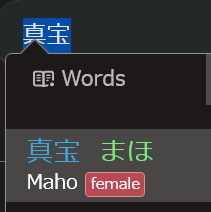

Q: Where did the character's names come from?
A: They were mostly from the story writer, Kishimoto, but they are dirived from the tale of 1001 nights. Arajin is of course Aladdin, Matakara is "mahou = magic", Zabu is "flying carpet → zabuton". However, only Mahoro doesn't have anything to do with the tale of 1001 nights (lol). All of the ateji is inspired by the yanki use of 夜露死苦 (read yoroshiku which means please treat me kindly but the characters mean night dew painful death). As in the title ぶっ契り(Bucchigiri, serious pledge) マジ(本気)フレ (majifure, true friends, but can be imaginary friend) things like that (lol).
(Animage April 2024)
Also, sorry.... The 契り is definitely from making a agreement/pledge (契約 keiyaku) with a genie but I laughed when I looked at the dictionary.

58 notes
·
View notes
Text
Daily Danganronpa Fun Fact #71
The back of the motorcycle in Mondo's execution says "痴美苦露惨母" or "Chibi Kuro Sanbo", which is the Japanese title for Little Black Sambo. Like his gang, it is also written in ateji, so 痴美苦露惨母 doesn’t mean Chibi Kuro Sanbo, it’s only pronounced that way.

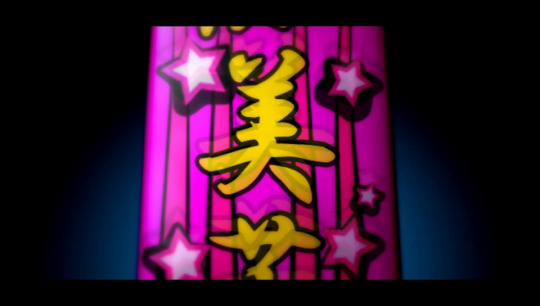
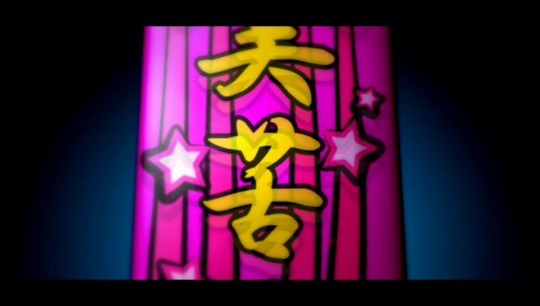

Home | Previous Fact | Next Fact
55 notes
·
View notes
Photo

Utagawa Kuniyoshi
Katsuo かつお (Bonito) / Neko no ateji 猫の当字 (Cats' substitute characters)
1842 (circa)
Woodblock print, oban tate-e. Cats twisting in the air, holding bonito fish (katsuo), from a series of cats forming the kana characters for the names of fish.
1K notes
·
View notes
Text

Utagawa Kuniyoshi - 日本語: 猫の當字 (Neko no Ateji) (Cats as a Word). Contorting cats join force to make the hiragana syllables なまづ (from top-right), meaning "catfish". Color Woodblock print, c.1842.
116 notes
·
View notes
Text
reading demon slayer: chapter 16 name breakdown
the last chapter of volume 2 has 2 names--how fitting. i don't believe the other demons that tanjirou has fought up to this point have had names, so this is a special occasion!
first we are given the name of the male demon,
矢琶羽
read as やはば. 矢 (や) means arrow, obviously a nod to yahaba's blood demon art. 琶 (は) is mostly found in words relating to the 琵琶 (びわ), which is a type of japanese string instrument. i think the inclusion of this kanji is a reference to the 琵琶法師 (びわほうし) of old. they were street performers, often blind, who played the biwa and recited poetry to make money. they also frequently dressed in buddhist garb.
yahaba isn't blind, per se, since his eyes are usually just on his hands, but he certainly looks the part. and his chunky necklace reminds me of buddhist mala, or prayer beads. many websites say yahaba's necklace is just a pearl necklace. however, i have not found a source to back up that claim, so i think i can speculate here.
i will note that mala usually have 108 beads, and yahaba's necklace is never pictured with more than 10 beads. but sometimes mala can be smaller. these smaller versions typically use factors of 108 as the total number of beads, and a factor of 108 is 12. with this knowledge i believe it is safe to assume that yahaba's necklace is meant to have 12 beads (perhaps plus one more, the mother bead) and the remaining beads are simply not drawn because they are obscured by his neck.
a 12-bead necklace would also be symbolic of the twelve demon moons, of which yahaba and susamaru claim to be members. if there is indeed a 13th mother bead, that could symbolise kibutsuji himself, as the father of all demons. but i digress.
the third character in yahaba's name, 羽 (ば), can mean feather or wing. it is also used as a counter for certain small animals (e.g. birds and rabbits). when paired with 矢, as in 矢羽 (やばね), we get a word meaning arrow feathers. this is probably the reference the author intended to make.
unfortunately yahaba's name doesn't make a neat sentence or phrase, but it does convey his powers and has a historical reference, so that's cool too.
after yahaba, we are given the name of the female demon,
朱紗丸
read as すさまる. you might already recognize the third kanji, but hold on! we'll get there in a minute. the first character 朱 (す) generally means red. it can specifically refer to a cinnabar, vermilion, or scarlet color. susamaru's orange eyes, kimono, and red-orange tipped hair reflect this part of her name.
紗 (さ) means silk gauze, and shows up in words regarding delicate fabrics like silk or gauze. it is also used as ateji in words about thicker fabrics like felt, chintz, and wool. 丸 (まる) means circle. if you recognized it from the start, nice! traditional temari are said to be made of fabric scraps from kimono and other household items, so a temari could be thought of as a fabric ball--a 紗丸.
that means susamaru's name is literally scarlet fabric ball. and i mean, her temari do have red on them. her and yahaba's names are very similar in that they both allude to their powers and parts of their designs. i expect we'll see this pattern repeated in the naming of future demons, but i may be surprised.
i believe that's all for this chapter's name breakdown! i especially enjoyed researching and writing the part about yahaba's necklace. i hope you did too. thanks for reading, and please look forward to the next posts! 読んでくれてありがとう!次の投稿を楽しみにしてください!
3 notes
·
View notes
Text

this is such a clever lyric
"why is it that the character for happiness (幸せ) contains the symbol for money (¥, denotes yen but uses the ateji of "kane")"
8 notes
·
View notes
Text
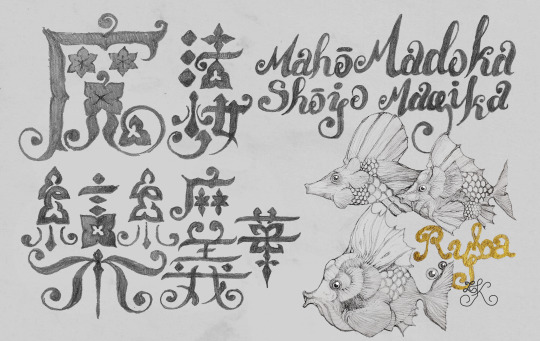
my attempt at calligraphy and fish yes i know it's "magica" not "magika" but i forgot oopsie
i will be forever spell "Madoka" as 欒 and no one can stop me (the "magika" kanjis are ateji btw)
13 notes
·
View notes
Text

A cool name today, very uncommon but made of common kanji. 伊比 is read Ibi or Ihi. (Walking by, "Do you think it's ee-hee, like Michael Jackson?"—"I think probably yeah.") It's also cool because both characters originated a katakana character and are used to represent a country.
伊 is a character I'm surprised we haven't done in depth! It can be read kare or i, and it's the source of katakana イ i. Its original meaning was "that one," but being so simple to write made it perfect for ateji,* and it came to mean Italy (originally 伊太利, today イタリア), which is what it usually means today. You also see it often in Japanese surnames and place names.
比 is read kura.beru (比べる to compare) or hi. It's the source of katakana ヒ hi. It means compare, race, or ratio, and it's also used as ateji to refer to the Philippines (though its nowhere near as common as 伊 for Italy).
#kanji#japanese langblr#learning japanese#had to look up the full ateji for philippines: 比律賓#whew!#and w/r/t 伊太利#all three are pretty commonly used in ateji#and are safe guesses#if you ever are in the position to guess ateji for something
34 notes
·
View notes
Text
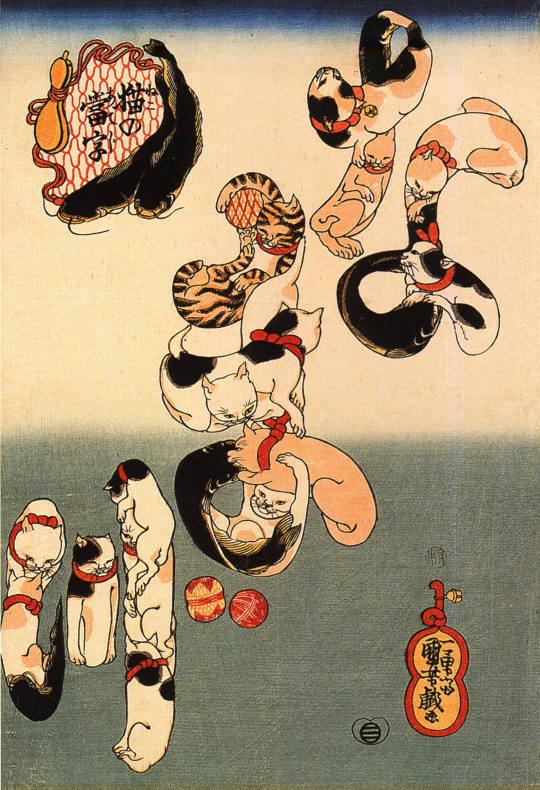
Another #FishFriday and #Caturday crossover courtesy of Utagawa Kuniyoshi: a clowder of cats spelling out the word for catfish (namazu) in kana (Japanese syllabary). One of a series of similar “cat words” called Neko no ateji, c. 1842. See them all here: http://kuniyoshiproject.com/Cat%20Homophones%20%28R196%29.htm
Utagawa Kuniyoshi (Japanese, 1798–1861)
Title: なまづ (Namazu) = Catfish
Series Title : 日本語: 猫の當字 (Neko no Ateji) = Cats as a Word
Description: Contorting cats join forces to make the hiragana syllables なまづ (from top-right), meaning "catfish". (ukiyo-e, giga)
Date: between c. 1841-1843 [c. 1842]
Medium: woodblock print
Dimensions: height: 36 cm (14.1 in); width: 25 cm (9.8 in) , ôban
References: A variant image at the Kubosō Memorial Museum of Arts (和泉市久保惣記念美術館), Izumi, Osaka.
#cat#cats#fish#fishes#catfish#ukiyo-e#woodblock print#print#illustration#works on paper#Japanese art#Asian art#19th century#Utagawa Kuniyoshi#Edo#Kuboso Memorial Museum of Arts#animals in art#Fish Friday#Caturday
42 notes
·
View notes
Text
The Name "Saragimaru"
A Challenge From JynX
Now that Kanae's 80-hour BotC work marathon is over and I am free man once more, I've suddenly gotten an inexplicable burst in motivation to work on the JynX & Len’en Tweet Collection.
It's exactly what it sounds like, Twitter is, well what it is, these days, and it'd be a shame if we lost such a treasure trove of Len'en history and lore.
It is in the middle of this that I stumbled across this pair of tweets, which is quite interesting indeed:

RIP Clause aside, what really got me is that bit about Yaorochi and Saragimaru's inspirations, especially that bit about how their inspiration right there on their names.
With Yaorochi it's extremely obvious, both its pronunciation and kanji clearly allude to Yamata-no-Orochi; But with Saragimaru, things fall apart real fast. What on earth was their name based on?
Let's take a very, almost certainly overly close, look at the name Saragimaru (蛇穴丸), and try to piece together what it may be about.

Splitting the Name
This is a completely blind area of research for me, and I could scarcely find anything about this on both Japanese and Chinese wikis that had Len'en information.
Searching Saragimaru (蛇穴丸) on its own got me nothing but Len'en either, so I decided to split the name in the most logical way I could think of: Saragi + maru. Now let's take a look at them separately.
Maru
-maru (丸 lit. "circle, round") is a fairly common tomeji (止め字), suffixes commonly added to kanji names, such as ko (子 e.g. Kanako 可南子 or Minako 美奈子) or tarou (太郎 e.g. Kentarou 健太郎 or Kotarou 虎太郎).
Nowadays, -maru is most commonly associated with ship names, but it's still used in a wide variety of names, from people to animal to object names.
It's unclear where it originated from, but a dominant theory is that it comes from the Heian period first-person pronoun maro (麿 or 麻呂). This later came to be added to the names of people who were loved and respected.
This idea of love and treasuring the thing being named would become one of the central ideas of the -maru suffix, often being attached to pet names, especially dog names, as well as names of swords.
Additionally, it's believed that maru, meaning "round", was a euphemism for excretion. It's thought that naming someone with particularly loathsome names could actually protect them from demons and disasters, so they were commonly used for the names of young boys, especially those who were to become warriors.
It is this last angle that I think is relevant here, -maru as a tomeji used for warriors. Saragimaru is certainly a warrior themself, wielding both a one-handed sword and a naginata.
To be honest, this whole ramble about the -maru ateji could really end up being nothing. On one hand, -maru is very likely just another ateji for the everyday Japanese person, but on the other, this is JynX we're talking about, so I though to give it a dive all the same.
Saragi
Now onto the main focus, Saragi (蛇穴), the good thing is that this was a phrase that shows up intermittently throughout Japanese history, so we do have several possibilities to go off of.
Unfortunately, none of them really feel that connected to Saragimaru, so I'm not sure if I'm on the right track at all. Nevertheless, let's check these out from most relevant to least.
Saragi and Autumn
First, let's ignore the reading of saragi and just look at the written phrase 蛇穴, literally "snake hole". It's used in a kigo (季語), words or phrases associated with a season in traditional Japanese poetry.
The phrase is "entering the snake's hole [nest]" (蛇穴に入る), which points autumn in the 9th traditional month, since that is when snakes enter their burrows and hibernate.
This is potentially relevant as EMS in fact takes place in autumn.
Saragi and Pottery
Next, we look at a proposed etymology of the word saragi.
It's believed that the way snakes curled themselves up to dig their burrows used to be called saraki (さらき), this was later loaned to refer to clay pottery, as the process of shaping the pottery was compared to a snake curling up.
This would be relevant to Saragimaru through Sukune Kanato, a clay pottery artisan with whom Saragimaru had some dealings, even requesting the clay replica of the Tasouken from them.
Saragi Village
There is a settlement named Saragi (蛇穴), located in Gose City, Nara Prefecture. There are several theories as to how this name came to be, and is where the above point came from.
But rather than the name itself, what I'd like to draw attention to is a local festival, the "Snake-pulling Soup-scattering Festival" (蛇曳き汁掛け祭り), which takes place on the 5th May every year.
The story goes En no Gyōja (役行者), an ascetic and mystic said to be the founder of Shugendō (修験道), would pass through Saragi Village every day on his way to train on Mount Katsura.
A young girl from the village fell madly in love with En, but he would not even glance at her. Eventually, her feelings grew so strong that she transformed into a snake and chased after him.
However, it happened to be the rice-planting season, and the villagers were working in the field. It was then that they saw a giant snake spewing fire as it slithered across the field.
In their fear, the villagers took the miso soup that was meant to be a light meal for the field workers, and threw it at the snake, chasing it away. The villages gave chase, finding that it ran into a well. They covered the well up with a great boulder, trapping her.
There they built the Noguchi Shrine (野口神社), next to the well the snake was sealed in, to enshrine and provide for the girl's spirit.
The shrine is also dedicated to a dragon god, who has dominion over water. While it's not too clear where it comes from, it seems safe to me to assume that it's the same great snake that the girl transformed into, especially since snakes and dragons were often considered similar beings having power over water.
Below: The "Snake Mound" (蛇塚), where the snake is said to have fled into.
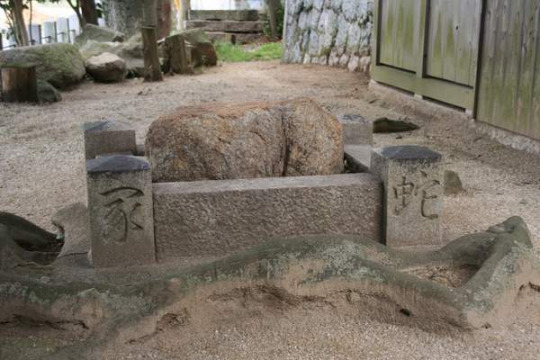
This leads to the "Snake-pulling Soup-scattering Festival", which, as the name implies, has two major events.
First is the "soup-scattering", which is believed to summon rain for good harvest in the coming year.
It used to be that the miso soup is actually thrown at the attendees of the festival. Though because the soup is actually constantly heated by fire, this is no longer done for safety concerns.
Below: The priest of the shrine scattering the soup, yes this is literal.

Next is the Snake-pulling, a giant snake made out of rice straws is made, said to carry the blessing of the dragon god of the Noguchi Shrine, and is even offered a whole bottle of sake.
It's brought to every house of the village, ensuring everyone gets a good harvest. At the end of the parade, its brought to the well, where it's positioned to sit in a coiled position over the well.
Below: The great straw snake atop the well.
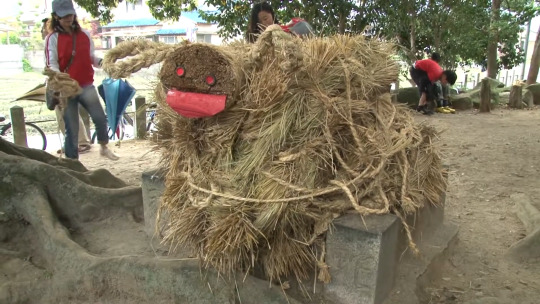
That concludes, roughly, the tale of Saragi Village and its extremely unique festival (with some extra details too cause dang it's interesting).
There could be some rough threads drawn between the two
The girl's all-consuming love for En no Gyōja could be compared to Saragimaru's intense devotion to Yaorochi.
The girl's transformation into a great snake, rendered similarly as 大蛇 (lit. "giant snake") in the records.
The festival's purpose to calling upon rain could relate to Saragimaru's ability to manipulate cloudy weather.
In the end I won't say it's really a perfect fit for Saragimaru, but it's certainly the closest I think any of these saragi-related lines of thought have brought us.
Conclusion
And that's really all I was able to find, no satisfactory conclusion this time, just a few potential connections for you to ponder on and drawn your own conclusions with.
This, at the very least, would placate my burning desire to figure out what JynX really means with that tweet, even if it's not the right answer.
As usual, I hope you enjoyed~! :)
#len'en#len'en project#len'en lore#adagumo no saragimaru#I do want to post more#but I'm really juggling so many things at once#that and I can't really think of any ideas#since I don't really want to just regurgitate the wiki#especially since like at least half of the mythology/history stuff there was already written by me#I'd rather explore more shaky connections and obscure stuff here#though I suppose my idea of obscure is probably very skewed at this point#feel free to ask for stuff as always~#also BotC is nearing release!!#big excitement
17 notes
·
View notes
Text
I'm not able to read the Japanese quite well enough to be sure, but there's some overlay between Setsuna and Weatherman that seems to go beyond their status and hint at their being the same person...? Or narrative doppelgangers, or some other odd thing.
The name Setsuna is actually derived from Sanskrit "kshana" and denotes in Buddhist scripts the smallest interval of time experienced by the mind. Weatherman has one attack in his repertoire 大時化 (Ohshike) that refers to stormy whether at sea... but the ateji for the (Kanji used primarily for pronunciation instead of meaning) would mean 'big time change', putting it in the same notional field as Setsuna. Since Weatherman uses this technique when Sunraku swipes his sword, you might infer that the sense of loss (or impotence?) reminds the Weatherman of the circumstances under which he lost Setsuna...? Or imply that Setsuna is the soul of the sword or something. But there was another possible pun
When the ghost/hologram of Setsuna calls herself the "vestiges of Setsuna", the word she uses is 残滓 (zanshi). It has two homophones, one that refers to a tragic death (惨死) and another that refers to dying of shame (慙死) -- both of which, though the latter especially, seem relevant to the mysterious circumstances of Weatherman's "death"? That's as far as I've gotten, but something feels off. The story has so far had a girl mistaken for a boy AND a boy mistaken for a girl AND a girl named "arthur pencil-gone" AND there was a couple frames juxtaposing Sunraku's Kabuto beetle helmet with a similar helmet on Weatherman that lacks a central spike, so there's some castration anxiety afoot and/or something vaguely transgender and/or some other mode of preoccupation with penis possession. Bugs me that I can't tell
2 notes
·
View notes